This feature highlights a number of meteor showers, comets and asteroids which are visible during the month of April 2009. The month sees the return of the borderline major meteor shower, the Lyrids. The highlight of the month is the lunar occultation of Venus right before dawn on April 22.
Note: If anyone has pictures or observations of these objects/events and want to share them, send me a comment. I’ll post them here.
Planets
Mercury – This month brings us the best opportunity of the year to observe Mercury in the evening sky (for Northern Hemisphere observers). Mercury will be at its highest on April 26, though even then it will be low in the western sky 30-60 minutes after sunset.
The Moon will also located just above Mercury on the evening of April 26. The image below shows what the scene will look like from North America. Note that the Pleiades open star cluster will be located between Mercury and the Moon. It will be a great sight via your eye or binoculars. In a telescope, Mercury will appear as a fat crescent with ~36% of its disk illuminated.
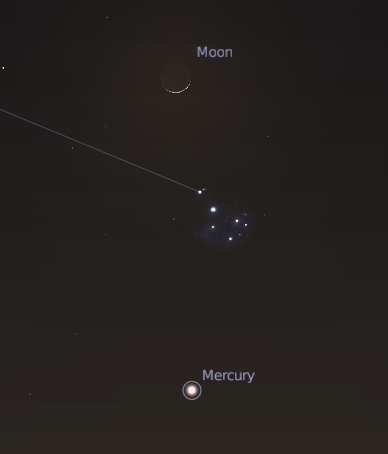
Saturn – Saturn is the only planet visible in the evening sky. By the end of twilight, Saturn is high in the southeast under the eastern part of the constellation of Leo.
This year Saturn is dimmer than usual. At magnitude +0.6 to +0.7, there are at least 11 stars that are brighter than it. The reason is that the rings of Saturn contribute a lot to the brightness of Saturn. But this year, is a ring plane crossing year meaning that the rings are nearly edge-on. As a result, the rings are reflecting much less light in the Earth’s direction this year. Saturn’s appearance through a telescope will match the below image taken by Bob Lunsford on March 28. Note the small dark spot near the top edge of Saturn’s disk, this is a shadow cast by Saturn’s largest moon, Titan.
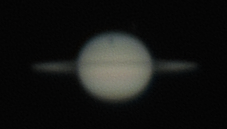
The Moon will pass a relatively distant 5.5 degrees to the south of Saturn on the evening of April 6.
Venus – After spending the past few months dominating the evening sky, Venus will now spend the rest of the year as a morning object. If you live south of the Equator, Venus will appear to rocket higher and higher every morning. In fact it should be an easy sight by the 2nd week of April if you have a clear eastern horizon. Venus will reach its highest in late May.
For those of us north of the Equator, Venus will take a little longer to gain altitude. Though it is already visible for observers with a clear eastern horizon, Venus will slowly climb higher every night. For northern observers, Venus won’t reach its highest till August. Regardless of where you are observing, Venus will be at its brightest on April 29 though it is always a very bright object.
For binocular and telescope users, Venus will start the month as a large thin crescent, 59″ across and only ~2% illuminated. By mid-month, it will have shrunk to ~50″ across but it will also become a fatter crescent with ~12% of the disk illuminated. By the end of the month, it is 39″ across and 25% illuminated
Venus is also involved in the coolest event of the month. On the morning of April 22, the Moon will occult (or pass in front) of Venus for observers in most of North America. The below map from the International Occultation Timing Association (IOTA) shows where the occultation will be visible. Times for the beginning and end of the occultation can be found at IOTA’s site. I’ll write more about this as the date draws closer.

The following diagram gives a good representation of what the occultation will look like right before the Moon passes in front of Venus on the morning of April 22. Note that Mars will be located nearby as well. For those with binoculars or a telescope, Venus will appear as a thin crescent similar to, but much smaller than, the Moon.

Jupiter – Jupiter rises a few hours before sunrise. Other than Venus, it is the brightest “star” in the morning sky at magnitude -2.2. Due to Jupiter’s location in the southern constellation of Capricornus , it never gets very high this year.
Mars – Mars can be seen very low in the eastern sky all month long. At magnitude +1.2, it is only as bright as some of the brighter stars. Venus will pass a distant 5.5 degrees to the north of Mars on April 24. As a result, Mars will be located just below the spectacular Moon-Venus occultation.
Meteors
The month of March experiences no major showers and only a few minor ones. It continues the annual lull in meteor activity from mid-January to mid-April.
Sporadic Meteors
Sporadic meteors are not part of any known meteor shower. They represent the background flux of meteors. Except for the few days per year when a major shower is active, most meteors that are observed are Sporadics. This is especially true for meteors observed during the evening. During April, 8 or so Sporadic meteors can be observed per hour from a dark moonless sky.
Major Meteor Showers
Lyrids (LYR)
April brings the first major meteor shower since the Quadrantids in early January. The Lyrids are produced by Comet Thatcher, a comet on a ~400 years orbit that has only been observed in 1861. The Lyrids, on the other hand, can be seen every year.
The radiant is located between the constellations of Lyra and Hercules. Though the radiant rises during the evening, the best time to see Lyrids is after 11 pm when the radiant is high in the sky.
The shower is active from April 16 to 25 with a peak on the morning of April 22. The shower only shows good levels of activity on the night of the peak. Even then, this is the most minor of the major showers with a peak rate of ~15-25 meteors per hour.
Though there are no predictions on enhanced activity, the Lyrids have been known to put on grand displays. The 1st great display goes back almost 25oo years while the last happened in 1982. So you never know, this year could be the next good display.
Minor Meteor Showers
Minor showers produce so few meteors that they are hard to notice above the background of regular meteors.
Pi Puppids (PPI)
The Pi Puppids are usually a very low activity shower. In 1977 and 1982, the shower put on a good display with up to 60 meteors per hour being observed. This shower radiates from the far southern constellation of Puppis and can not be seen from most of North America and Europe.
We now know that the Pi Puppids are created by Comet 26P/Grigg-Skjellerup. P/G-S is a small Jupiter family comet that orbits the Sun once every 5.3 years.
There are no predictions for enhanced material this year. The shower is active from April 15-28 with a peak on April 23. At its best we should expect 1-2 meteors per hour with even that number being optimistic for northern observers.
Eta Aquarids (ETA)
The Eta Aquarids are a major shower, especially for southern hemisphere observers, when they peak on May 5. During the month of April, the shower can be considered a minor shower.
The ETA were produced by Comet Halley which also gives us the Orionids in October. Models suggest that the ETA were released by Comet Halley no later than 837 AD. The Orionids are easy to see because the particles are hitting the Earth from the anti-solar direction. This means the meteor shower can be seen in the middle of the night. The ETA are produced by meteoroids moving outbound from the Sun, as a result the radiant is located relatively close to the Sun. This means that the ETA radiant is only visible for an hour or so before twilight.
The shower spans from April 19 to May 28 with a peak around May 5 with a maximum ZHR of ~60. The last week of April will see some low activity (ZHR < 10) from the ETAs.
Additional information on these showers and other minor showers not included here can be found at the following sites: Robert Lunsford’s Meteor Activity Outlook, Wayne Hally’s and Mark Davis’s NAMN Notes, and the International Meteor Organization’s 2008 Meteor Shower Calendar.
Comets
Naked Eye Comets (V < 6.0)
None
Binocular Comets (V < 8.0)
None
Small Telescope Comets (V < 10.0)
Comet C/2009 E1 (Itagaki)
This recently discovered comet was found by amateur astronomer Koichi Itagaki of Yamagata, Japan. Comet C/2009 E1 (Itagaki) is a long-period comet which will come within 0.60 AU of the Sun at perihelion on April 7. It is also periodic in that it returns once every ~250 years according to the latest orbit.
This is the 1st comet to bear Koichi Itagaki’s name but it is not his 1st discovery. Back in 1968, he was a co-discoverer of Comet Tago-Honda-Yamamoto. Due to the rule that only the 1st 3 discoverers can have their name attached to a comet, his name was left off. Only a few months ago, he also re-discovered long-lost comet Giacobini.
The comet is located in the evening sky north of the constellation of Aries. As the month progresses the comet will move north of the Sun as it travels through Triangulum, northern Pisces and Andromeda. Only observers with a clear view of the northwestern horizon in the evening and northeastern horizon in the morning will be able to see the comet. By May the comet will only be visible in the morning sky and will be much easier to see.
At magnitude ~8.0 to 8.5, the comet is bright enough to be seen in a reasonably sized backyard telescope. Having said that, I was just barely able to see it from my backyard in Tucson with my 12″ telescope due to the city lights and the bright twilight.
A finder chart for Comet Itagaki can be found at Comet Chasing.
A nice collection of images can be found at the VdS-Fachgruppe Kometen (Comet Section of Germany).
Comet C/2009 F6 (Yi-SWAN)
A new comet has been discovered that should be the brightest comet in the sky this month. Comet C/2009 F6 (Yi-SWAN) is a long-period comet which will pass within 1.27 AU of the Sun on May 8. The comet is currently around magnitude 8.5 making it bright enough to be seen in small telescopes. Right now the nearly Full Moon will make observing the comet difficult but in a few days the Moon will not be a problem for evening observers. The comet is located north of the Sun. For southern hemisphere observers, you are out of luck. For northern observers, the comet can be observed in both the evening and morning sky.
Currently the comet is located in Cassiopeia. It is moving to the east and will enter Perseus by mid-month. The comet should continue to brighten as it approaches perihelion and may be as bright as magnitude 8.0.
On the morning of April 21, I was able to observe Yi-SWAN with 30×125 binoculars. My observing location isn’t too dark with a limiting magnitude of ~+5.5. Even then, the summer Milky Way was faintly visible. The comet was barely visible as it was large and diffuse. Interestingly, the comet was not visible during multiple attempts to observe it during the evening hours. The darker morning sky most definitely helped.
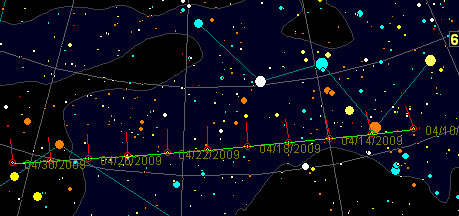
The comet was found by Dae-am Yi of Yeongwol-kun, Gangwon-do, South Korea on March 26. He noticed the obvious blue-green glow of a comet on 2 images he took with a Canon 5D digital camera and a 90-mm f/2.8 lens. The other discoverer was Robert Matson of Irvine, CA. Mr. Matson found the comet on a series of images taken with the SWAN instrument on the SOHO (Solar Heliospheric Observatory) spacecraft starting on March 29. The SWAN insturment images the entire sky for solar Lyman-alpha particles that are backscattered off of neutral hydrogen atoms. In this way, SWAN can monitor the activity of the far-side of the Sun. This instrument is also excellent at detecting the glow of hydrogan in the extended coma of comets.
Comet C/2007 N3 (Lulin)
Comet Lulin was discovered by the Lulin Sky Survey in Taiwan on 2007 July 11. At the time the comet was located beyond the orbit of Jupiter. The comet will be closest to the Sun on 2009 January 10 at 1.21 AU from the Sun. It will be closest to Earth in late-February when it will be only 0.41 AU from us.
The comet is fading after its closest approach to Earth in late February. It is a evening object and spends all of April moving westward through western Gemini. The comet starts the month around magnitude 8.5 and should fade to magnitude 10.0 or fainter by the end of the month.
A finder chart for Comet Lulin can be found at Comet Chasing.
A nice collection of images can be found at the VdS-Fachgruppe Kometen (Comet Section of Germany) and Seiichi Yoshida’s Comet Homepage.
Comet C/2006 W3 (Christensen)
This comet was discovered over 2 years ago on 2006 November 18 by Eric Christensen of the Catalina Sky Survey north of Tucson. At the time the comet was located at 8.7 AU from the Sun which is nearly the distance of Saturn. The comet continues to move closer to the Sun and Earth and is currently 3.8 AU from the Sun and 3.4 AU from the Earth.
The comet is currently around magnitude 9.5 and will slowly brighten during the month. It is moving near the border of Lacerta and Pegasus. The comet is best seen in the early morning. I was able to observe the comet visually with my backyard 12″ reflecting telescope back in November. Being small and condensed, the comet was fairly easy to see.
The comet will continue to brighten as it approaches perihelion at a still rather distant 3.12 AU from the Sun on 2009 July 6. At that time, the comet will be 8th magnitude and visible in many smaller backyard telescopes and even binoculars from dark sites. Christensen should remain bright enough to see in modest sized backyard telescopes for all of 2009.
On the morning of April 21, I was able to observe this comet with both 30×125 binoculars and a 12″ dobsonian. The comet was much easier to see in the 12″. Observation was made under a moderately light polluted sky with a limiting mag of ~+5.5.
A finder chart for Comet Christensen can be found at Comet Chasing.
A nice collection of images can be found at the VdS-Fachgruppe Kometen (Comet Section of Germany) and Seiichi Yoshida’s Comet Homepage.
Asteroids
Binocular and Small Telescope Asteroids (V < 10.0)
(1) Ceres
Ceres is the biggest asteroid in the Main Belt with a diameter of 585 miles or 975 km. It is so big that it is now considered a Dwarf Planet. Classified as a carbonaceous (carbon-rich) Cg-type asteroid, there are suggestions that it may be rich in volatile material such as water. Some even propose that an ocean exists below its surface. Ceres is one of two targets for NASA’s Dawn spacecraft which is scheduled to visit it in 2015. Last month Ceres was at opposition (at its closest to the Earth and at its brightest). This month Ceres will fade from from magnitude 7.4 to 8.0 as it ends is retrograde motion just north of Leo. If you are observing Saturn with a telescope or pair of binoculars, try your hand at finding Ceres with one of the finder charts linked below.
A finder chart (needs to be flipped upside down for Northern Hemisphere observers) can be found at the Royal Astronomical Society of New Zealand. Finder chart for Ceres from Heavens Above.
(2) Pallas
Pallas is also a carbonaceous asteroid though with a slightly bluish B-type spectrum. Due to its high inclination (tilt of its orbit with respect to Earth’s orbit) of 34 degrees it is a difficult target for future spacecraft missions. Pallas is large with dimensions of 350x334x301 miles or 582x556x501 km. This month it continues moving north, leaving the constellation of Orion and entering Monoceros. It fades from magnitude 8.7 to 8.9 over the course of the month.
A finder chart (needs to be flipped upside down for Northern Hemisphere observers) can be found at the Royal Astronomical Society of New Zealand. Finder chart for Pallas from Heavens Above.
(8) Flora
Flora is a large asteroid roughly 136x136x113 km in dimension. It is innermost large asteroid in the Main Belt. As a result, it can get bright enough for backyard observers with modest sized telescopes and binoculars. Flora is a stoney S-type asteroid and also the largest member of the Flora family. This family was created when a large impact occured on Flora. The other family members are pieces of Flora that were thrown off by the impact.
Flora starts the month at magnitude 10.0. It reaches its maximum brightness on April 22 at magnitude 9.8. By the end of the month, it has slightly faded to 9.9. Flora and Irene provide us with a 2-for since both objects are located within 5 degrees of each other.
Since there I have not been able to find a nice star chart showing the position of Flora, here is one I made with the C2A program. It also shows the position of Irene.
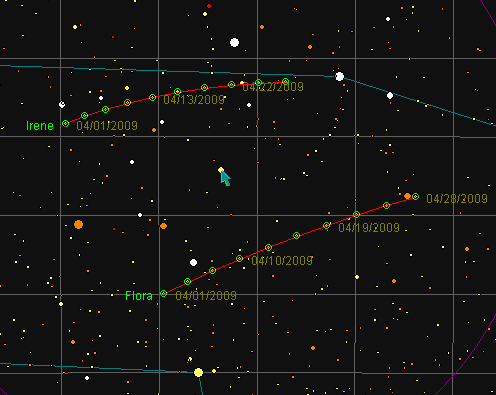
(14) Irene
Irene was discovered by John Russel Hind in 1851, being only the 14th asteroid known at the time (if you are wondering ~400,000 asteroids have been discovered to date, we’ve come a long way). It is an S-type asteroid with a stoney or silicate composition. Its takes 6.3 years to orbit the Sun.
This month Irene will brighten from magnitude 9.2 to a maximum of 8.9 on April 24 as it retrogrades through western Virgo. Remember Flora is located within 5 degrees of Irene.
(15) Eunomia
Discovered in 1851, Eunomia is one of the largest stoney S-type asteroids. Its dimensions are roughly 357×255×212 km. Similar to Flora, Eunomia is also the parent body of its own family.
Eunomia spends all of April in the constellation of Corvus, just to the south of Virgo. With opposition on April 2, the asteroid is as bright as it’s going to get this year at magnitude 9.8. As the month progresses it will fade to 10.0. This year Eunomia is at aphelion, its furthest from the Sun making this one of its faintest oppositions. When at perihelion, it can get as bright as magnitude ~8.
Since there I have not been able to find a nice star chart showing the position of Eunomia, here is one I made with the C2A program.

(29) Amphitrite
Discovered in 1854, Amphitrite was the 29th asteroid to be discovered. Similar to Euterpe, Amphitrite is also a stoney S-type asteroid. With an average diameter of 127 miles (212 km) it is bigger than Euterpe though its further distance from the Earth and Sun keeps it from getting as bright.
Amphitrite fades from magnitude 9.5 to 10.1 this month. It spends the entire month in eastern Virgo not far from Saturn. If you are observing Saturn, take a short star-hopping trip to Amphitrite
Since there I have not been able to find a nice star chart showing the position of Amphitrie, here is one I made with the C2A program.
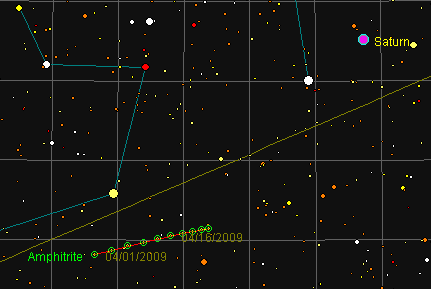


I live in Costa Rica and for several days now I have obserbved something huge in the early morning eastern sky. It is a very very bright light –easily 20 times bigger and brighter than any star — appearing around 4:30 am (that’s when I have seen it) almost opposite the Moon (on the western sky at that time). What is it? Could it be the ISS??? Is that where it would appear in the Costa Rican sky prior to sunrise?
Thanks
Hi Maria,
The “star” you are seeing in the eastern sky at dawn is Venus. Venus is always brighter than any other star and planet. For the past few months, Venus was an evening object but late in March it moved into the morning sky. Over the next few months, Venus will climb higher and higher in the morning sky. Not until early next year will Venus be visible in the evening.
Thanks for writing,
– Carl
In the last couple of months, the planet Venus has moved from being a bright “evening star” (Greatest Eastern Elongation 1/14/09), through being directly between the Earth and the Sun (Inferior Conjunction 3/27/09), and is now on its way to becoming a bright “morning star” (toward Greatest Western Elongation – in June 2009). The change happens quite rapidly. Currently Venus’s brightness magnitude is at -3.26 which is brighter than Sirius which is the brightest star in our sky. Nearby Venus is Mars and Uranus somewhat closer to the eastern horizon, while Jupiter is higher in the sky during the predawn hours.
i live in dundee scotland and at just after 9pm 17/04/09 i saw what might have been an asteroid or meteor? if someone else saw this maybe they know (id like to know)
april 22nd 2009 6 am (Portugal) , saw a bright orb like object, maybe a meteor i dont know, dont really understand anything about that.. all i know is that it was moving faster than a plane and for a very long while.
Hi Victor,
It looks like you saw the International Space Station. The ISS is very bright these days. It is easily brighter than any star and many of the planets.
I also saw the station last night will watching the Lyrid meteors. It was a brilliant yellow.
There is a website called Heavens Above (http://www.heavens-above.com/) where you can get predictions for when the ISS or any other satellite passes over your location. Once you enter your location, it gives times and star charts. This is the site I used to confirm that the station passed over Portugal around 6 am this morning.
Thanks for writing,
– Carl
Congratulations for your site! It contains very useful and updated information.
In Heavens Above I only could get the prediction for the next 10 days telling there are not going to be visible passes over my location 10°42´N 85°42´W in Guanacaste Costa Rica, for the next 10 days. Where can I learn about the next time ISS will be visible from my observation point? Thanks for your help.
Hi Marco,
Thank you for your kind words. I’m glad you’re finding my site useful.
A good source for satellite prediction is CalSky . The site allows you to make predictions out to 2 months.
Hope this helps,
– Carl
I live in Southampton, England and saw a slow shooting star? Can they be slow? It crossed the sky for about 10seconds? Around 5am? Bright white light…..went across the sky then down?
Am i seeing things? =)
xxx
Can you tell me if I can see pegasus on April.26 or 27 2009?
Hi Vandana,
Yes, you can see the constellation Pegasus tonight. There is a catch. Pegasus can only be seen an hour or so before sunrise. It will be low in the northeast sky.
– Carl
Did anyone see something in the sky tonight? It looked like a green shooting star, but it was too low and too bright to be one. Does any one know what it is? I wish I has a camera.
I saw this! It had to be a meteor because it broke into a dozen pieces when it his the atmosphere and then dissapated. Very bright and big!! I’m in Atlanta, GA. Where did you see it Jen?
I saw this! It had to be a meteor because it broke into a dozen pieces when it his the atmosphere and then dissapated. Very bright and big!! I’m in Atlanta, GA. Where did you see it Jen?
Maybe that is what i saw over Scotland Garrett as it broke up i only saw one piece, but you couldnt miss it as it was that big in the sky.Everyone who was driving stopped their cars to look, it was funny to see traffic at a standstill for this. He He!
i nned to know what time the star appears on may 14th, may 15th, may 16th, and may 17th. so can you tell me where i can find the answer on the internet or can you give me the answer!thnx!!!
please answer my qusetion and nvrmind my teacher said we don’t have to do tht but thnx anyway
Hi
I’m in Ayrshire Scotland and heard on the news tonight that there may be a meteor shower visible to the naked eye over the next couple of nights.
Any chance we could catch glimpse at this neck of the woods?
Thanks
I’m a high school student living in the Virgin Islands. I am an A student with AP classes planning to attend college, and with that being said, I hope you don’t deem me crazy from the jump. Some time in early 2009 (between Feb and May) at about 12 or 1 in the afternoon, I witneesed the moon moving in tiny little circles over short periods of time. The moon would slowly move in a semi-circle and about 2 minutes would pass, then I would find the moon in the same place it started after a few clouds pased. I was not moving, and two friends saw this as well.
Is there any plausible explaination for this?